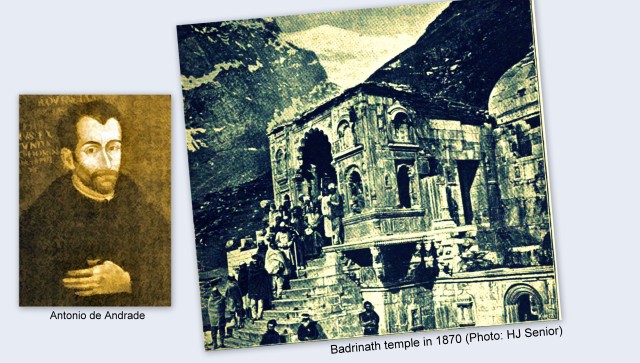The mass movement of pilgrims to the Hindu shrines located in the high Himalayas used to surprise foreigners during British rule. The devotees heading for Badrinath and Kedarnath in low-resource clothing and walking long distances in extremely challenging terrain used to baffle them. In the process of understanding the annual pilgrimage in the Indian Himalayas, many foreigners used to explore Badrinath and other shrines in Garhwal. Many took the pilgrimage route to secretly enter mysterious Tibet. First foreign explorer in Badrinath Portuguese Jesuit Antonio de Andrade was the first ever foreigner to reach Badrinath. Disguised as a Hindu devotee Antonio and his brother Manuel join a group of pilgrims in Agra on 20 March 1624. They had one intention of entering Tibet through Badrinath. Antonio perfectly adopted the costumes and language used by common Hindu pilgrims and he was hard to be identified as a foreigner. After Agra, he moved with the group to Haridwar and reached Srinagar (Garhwal). On suspicion, he was detained by the Garhwal king force. The security grilled him for 5-6 days in which the Portuguese disclosed his intention of exploring Tibet and entering the bordering country through Badrinath. He was allowed to move forward. After 15 days Antonio de Andrade reached Badrinath. The Garhwal King had issued strict instructions that the foreigner should not be allowed to cross Mana, a village near Badrinath. After staying 20 days in Mana and despite strong resistance from villagers, the Portuguese, his two Christian servants and a local villager started off for Tibet. After a six day trek the team got stuck in a snowstorm and abandoned their expedition. They would have died had the Mana villagers not come for their rescue. After getting clearance, Jesuit Antonio de Andrade crossed the border and established the first Catholic church on Tibetan soil. Historian Shekhar Pathak says, “Foreigners were barred from entering Tibet. Free entry of foreigners started in 1903-04 after invasion by British Indian Armed Forces to Lhasa. Before British rule the Garhwal King and the Tibetan Jong Pong used to provide permission to traders and to a limited number of pilgrims to visit Tibet. Both used to charge tax from them.” First painter English veterinarian and explorer William Moorcroft adopted Portuguese Jesuit Antonio’s formula to visit Garhwal in 1812. Disguised as Hindu pilgrims, William and his friend Hyder Young Hearseym – born to a British father and Indian mother – entered the Garhwal hills. The situation was challenging as the Gorkhas were ruling the area at that time. Both the travellers managed to comfortably enter the territory and they had a clear agenda to explore the Mansarovar lake in Tibet. [caption id=“attachment_13612182” align=“alignnone” width=“300”] A 1812 water colour painting by Hyder Young Hearseym during his Badrinath visit[/caption] Hyder Young Hearseym was a skilled painter and made a stunning watercolour painting of Badrinath on 29 May, with a view of Badrinath, snow-covered mountain in the background, three yaks and two boys in the foreground. On the backside of the painting the year mentioned was 1808. Hyder came once in the Chamoli area and it can be said, after matching his tour dates, that the Badrinath painting was made in 1812 and not in 1808. After waiting for 15 days to get permission to cross the border, Moorcroft realised that the Niti village headman was deliberately delaying the process. Moorcroft had to sacrifice a bottle of brandy to sweeten his relationship with the headman. The trick worked and they finally crossed the border on the last day of June. Early photographer The lure of the Himalayas brought Colonel Henry John Senior of the Bengal Native Infantry to Badrinath. In1870, he made his tour to Badrinath and documented his execution in an article, ‘A visit to Badrinath temple in the Himalayas’ for ‘Women’s Work for Women’ magazine in 1892. Henry John Senior was stunned by the grandeur of the Hindu shrines and wrote, “The temple of Badrinath was evidently intended to be a magnificent edifice. The gateway is beautifully designed and carved with elaborate sculpturing of elephants, peafowl, lions and emblems of royalty.” Senior was also a member of the Bengal Photographic Society and photographed a variety of subjects in India. He was possibly the first photographer to visit Badrinath. Early reference of pilgrimage Dedicated to Lord Vishnu, the Badrinath shrine in district Chamoli attracts visitors from far and near. The earliest reference about the pilgrimage trend in Badrinath can be found in East-India Gazetteer by Walter Hamilton, published in 1828. Proving vivid detail about the temple and the pilgrimage centre, the gazetteer states that in 1808 there were thirty huts in Badrinath for accommodation of priests and their attendants. Even in those days the movement of devotees in Badrinath was high as the book states, “The number of pilgrims who visit Badrinath has been estimated to 50,000, mostly religious mendicants and devotees from all quarters of India.” The Badrinath shrine is presently well connected with the road network. Last year over 18.36 lakh pilgrims came to offer prayers at the sacred temple in Uttarakhand. In the past covering the distance from Rishikesh to Badrinath on foot used to take months. The total foot-march, including the return journey, was about 540 km and pilgrims used to walk 16-24 km per day, depending on their fitness. Views expressed in the above piece are personal and solely that of the author. They do not necessarily reflect Firstpost_’s views._ Read all the
Latest News ,
Trending News ,
Cricket News ,
Bollywood News , India News and
Entertainment News here. Follow us on
Facebook,
Twitter and
Instagram.
Most of the foreign adventure lovers dreamt of touring Badrinath during the British period to get a feel for the annual Hindu pilgrimage. They also wanted to explore the chances of entering mysterious Tibet
Advertisement
End of Article


)

)
)
)
)
)
)
)
)



